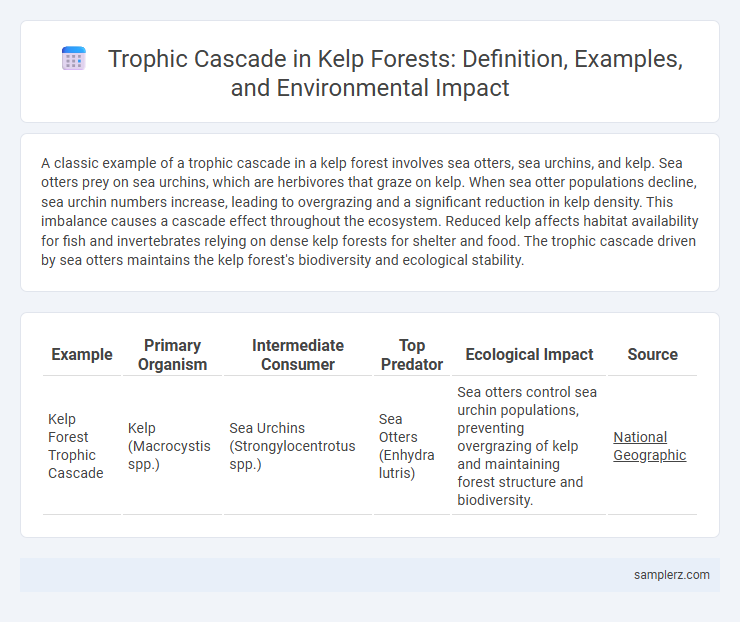A classic example of a trophic cascade in a kelp forest involves sea otters, sea urchins, and kelp. Sea otters prey on sea urchins, which are herbivores that graze on kelp. When sea otter populations decline, sea urchin numbers increase, leading to overgrazing and a significant reduction in kelp density. This imbalance causes a cascade effect throughout the ecosystem. Reduced kelp affects habitat availability for fish and invertebrates relying on dense kelp forests for shelter and food. The trophic cascade driven by sea otters maintains the kelp forest's biodiversity and ecological stability.
Table of Comparison
| Example | Primary Organism | Intermediate Consumer | Top Predator | Ecological Impact | Source |
|---|---|---|---|---|---|
| Kelp Forest Trophic Cascade | Kelp (Macrocystis spp.) | Sea Urchins (Strongylocentrotus spp.) | Sea Otters (Enhydra lutris) | Sea otters control sea urchin populations, preventing overgrazing of kelp and maintaining forest structure and biodiversity. | National Geographic |
Introduction to Trophic Cascades in Kelp Forests
Trophic cascades in kelp forests occur when changes in the population of apex predators, such as sea otters, lead to significant shifts in the ecosystem structure by controlling herbivore populations like sea urchins. The decline of sea otters results in unchecked sea urchin grazing, which causes kelp deforestation and disrupts habitat complexity. This cascading effect highlights the critical role of predator-prey dynamics in maintaining kelp forest health and biodiversity.
Defining the Kelp Forest Ecosystem
Kelp forest ecosystems are dynamic marine habitats characterized by dense growths of giant kelp, providing shelter and food for diverse species such as sea urchins, sea otters, and various fish. The trophic cascade in this ecosystem is illustrated by sea otters preying on sea urchins, which helps control urchin populations and prevents overgrazing of kelp. This predator-prey interaction maintains the structural complexity and biodiversity of the kelp forest, demonstrating the critical balance within the ecosystem.
The Role of Sea Otters as Keystone Species
Sea otters serve as keystone species in kelp forest ecosystems by preying on sea urchins, which are herbivores that graze on kelp. Without sea otters, sea urchin populations can explode, leading to overgrazing and the destruction of kelp forests. This trophic cascade highlights the critical role of sea otters in maintaining kelp forest biodiversity and ecosystem stability.
Sea Urchin Population Dynamics and Kelp Decline
Sea urchin population dynamics play a critical role in kelp forest ecosystems, where overgrazing by sea urchins leads to significant kelp decline. Predators like sea otters regulate sea urchin numbers, preventing the formation of urchin barrens and enabling kelp recovery. Disruptions in this predator-prey balance trigger trophic cascades that result in reduced biodiversity and altered nutrient cycling in kelp forests.
Impact of Predator Removal on Kelp Forest Health
The removal of sea otters, a key predator, leads to an overpopulation of sea urchins that graze heavily on kelp, causing significant declines in kelp forest density and biodiversity. This trophic cascade disrupts the marine ecosystem by reducing habitat complexity and shelter for numerous species reliant on kelp forests. Studies show that restoring predator populations helps control sea urchin numbers, promoting kelp recovery and enhancing overall ecosystem resilience.
Sea Otter Reintroduction and Ecosystem Recovery
Sea otter reintroduction in kelp forests triggers a trophic cascade by preying on sea urchins, whose overgrazing previously devastated kelp populations. This predator-prey dynamic allows kelp beds to recover, enhancing biodiversity and providing critical habitat for numerous marine species. The restored kelp ecosystem improves carbon sequestration and stabilizes coastal food webs, highlighting the importance of apex predators in ecosystem recovery.
Cascade Effects on Biodiversity in Kelp Forests
Predator decline in kelp forests, such as sea otters, triggers trophic cascades that cause sea urchin populations to explode, leading to overgrazing of kelp and drastic habitat loss. This cascade effect reduces structural complexity and biodiversity by eliminating shelter and food sources for numerous marine species. Restoration of predator populations can reverse these impacts, promoting kelp regrowth and enhancing ecosystem resilience and species diversity.
Interactions with Other Predators (e.g., Orcas)
Orcas influence kelp forest trophic cascades by preying on sea otters, which are key predators of sea urchins that graze on kelp. Reduced sea otter populations lead to increased sea urchin abundance, resulting in overgrazing and kelp forest decline. This predator-prey interaction highlights the top-down control orcas exert on the kelp forest ecosystem.
Human Influences on Trophic Cascades
Overfishing of sea otters in kelp forest ecosystems reduces predator pressure on sea urchins, causing their population to explode and overgraze kelp, leading to habitat loss and decreased biodiversity. Coastal pollution and climate change further stress kelp forests, weakening their resilience against trophic cascades triggered by altered predator-prey dynamics. Human-driven disturbances disrupt natural food web interactions, emphasizing the need for conservation measures to restore predator populations and maintain ecosystem balance.
Conservation Strategies for Sustainable Kelp Forests
Predator recovery, such as sea otter population restoration, drives trophic cascades that control sea urchin populations and promote kelp forest regeneration. Conservation strategies integrating habitat protection, predator reintroduction, and sustainable fisheries management enhance ecosystem resilience and biodiversity. Monitoring ecological interactions and mitigating human impacts are essential to maintaining the functional integrity of kelp forest trophic structures.

example of trophic cascade in kelp forest Infographic
 samplerz.com
samplerz.com